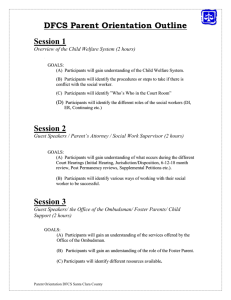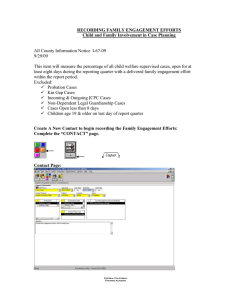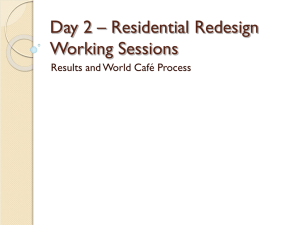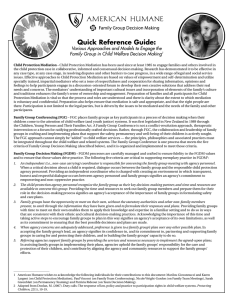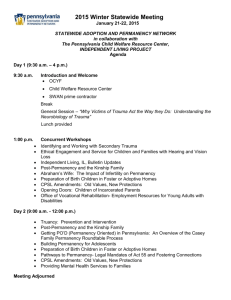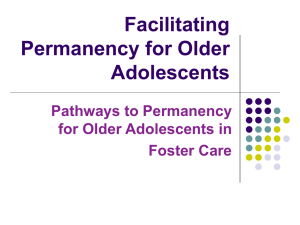Practice Model Landscape Summary
advertisement
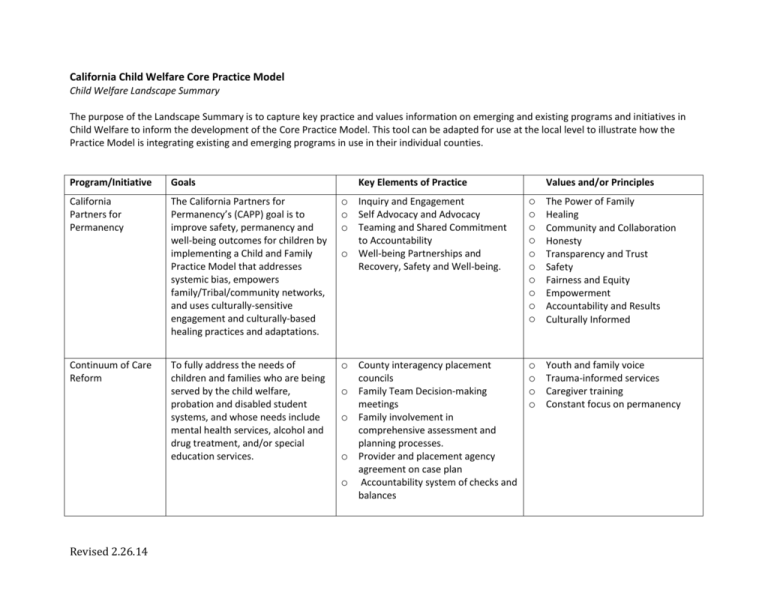
California Child Welfare Core Practice Model Child Welfare Landscape Summary The purpose of the Landscape Summary is to capture key practice and values information on emerging and existing programs and initiatives in Child Welfare to inform the development of the Core Practice Model. This tool can be adapted for use at the local level to illustrate how the Practice Model is integrating existing and emerging programs in use in their individual counties. Program/Initiative Goals California Partners for Permanency The California Partners for Permanency’s (CAPP) goal is to improve safety, permanency and well-being outcomes for children by implementing a Child and Family Practice Model that addresses systemic bias, empowers family/Tribal/community networks, and uses culturally-sensitive engagement and culturally-based healing practices and adaptations. o Inquiry and Engagement o Self Advocacy and Advocacy o Teaming and Shared Commitment To fully address the needs of children and families who are being served by the child welfare, probation and disabled student systems, and whose needs include mental health services, alcohol and drug treatment, and/or special education services. o County interagency placement Continuum of Care Reform Key Elements of Practice to Accountability o Well-being Partnerships and Recovery, Safety and Well-being. o o o o Revised 2.26.14 councils Family Team Decision‐making meetings Family involvement in comprehensive assessment and planning processes. Provider and placement agency agreement on case plan Accountability system of checks and balances Values and/or Principles o o o o o o o o o o The Power of Family Healing Community and Collaboration Honesty Transparency and Trust Safety Fairness and Equity Empowerment Accountability and Results Culturally Informed o o o o Youth and family voice Trauma‐informed services Caregiver training Constant focus on permanency Program/Initiative Goals Family to Family To develop a network of family foster care that is focused on safety, neighborhood-based, culturally sensitive, and located primarily in communities in which children currently live. o Recruiting, Developing, and To involve birth families and community members, along with resource families, service providers and agency staff, in all placement decisions, to ensure a network of support for the child and the adults who care for them. o TDM meeting includes birth parents TDM Family to Family Key Elements of Practice Supporting Resource Families o Building Community Partnerships o Making Decisions as a Team o Evaluating Results o o o o Katie A. Revised 2.26.14 To deliver an array of mental health services for children in foster care through a coordinated, comprehensive and communitybased system. o o o o o o and youth. Meeting is held for ALL placement decisions BEFORE the child’s move. Neighborhood-based community representatives participate. Skilled, immediately accessible, internal facilitator utilized. Information collected and linked to data on outcomes. Engagement Teaming Assessing Service Planning and Intervention Monitoring and Adapting Transition Values and/or Principles o o o o A child’s safety is paramount Children belong in families Families need strong communities Public child-welfare systems need partnerships with the community and with other systems to achieve strong outcomes for children o Every child deserves a family o Every family needs the support of the community o Public child welfare agencies need community partners o Services Are: Needs-driven, strength based and family focused Individualized and tailored to strengths A blend of formal and informal resources Culturally competent Provided in community o A multi-agency collaborative approach o Children are first and foremost protected from abuse and neglect o Children have permanency and Program/Initiative Linkages Parent Partners Goals To improve the coordination of Child Welfare Services and CalWORKs to produce better outcomes for the children and families who receive services. To engage parents more fully in the child welfare case planning and services process. Key Elements of Practice o Shared Vision o Leadership commitment o Coordinated assessments and To develop a statewide approach to recruiting and retaining high quality caregivers who provide excellent care to children in California’s child welfare system by rebranding foster care, not simply by changing a logo or an advertisement, but by changing the core elements underlying the brand. o o o services o Jointly trained workforce o Leveraged resources o Robust communication between o o Quality Parenting Initiative Values and/or Principles o o o CWS and CalWORKs and across stakeholders. Provision of information to parents about the child welfare system and their right and responsibilities. Provision of support, modeling, and linkages to assist families in meeting their safety, permanency, and wellbeing goals. Clear expectations of caregivers Articulated expectations Alignment of system and goals o o o Negative connotations of the o o o o Revised 2.26.14 stability Holistic perspective Reduces duplication of efforts Collaboration with internal and external partners Honors client choice Timely services in a respectful manner. brand make recruitment and retention difficult Branding requires all stakeholders to agree on foster parents roles and responsibilities System changes must support those expectations and be implemented by the people whom they affect Change is a continuous process Meaningful recruitment only occurs after substantial practice changes are accomplished. Program/Initiative Goals Resource Family Approval To implement a unified, family friendly, and child-centered resource family approval process that replaces the existing multiple processes, eliminates duplication, and increases approval standards by incorporating a comprehensive psychosocial evaluation of all families that want to foster, adopt, or provide legal guardianship to a child. To form a constructive, purposeful focus among all the stakeholders involved with children and families by generating a clear, shared understanding of the problems facing that family and a straightforward vision of what future safety for the children needs to look like. To engage with individuals with complex needs (most typically children, youth, and their families) in an intensive, holistic approach so that they can live in their homes and communities and realize their hopes and dreams. Safety Organized Practice Wraparound Revised 2.26.14 Key Elements of Practice Values and/or Principles o One application & background check o Combined home environment and permanency assessment o Pre-approval and post-approval training for all families o Placement procedures for child prior to resource family approval o Emergency placement o Compelling Reason o o o o o Signs of Safety Appreciative inquiry Solution-focused therapy Motivational interviewing Structured Decision-Making tools o Grounded in a Strengths Perspective o Driven By Underlying Needs o Supported by an Effective Team Process o Determined By Families o o o o o o o o o Family voice and choice Team-based Natural Supports Collaboration Community-based Culturally competent Individualized Strengths-based Unconditional(and/or “Persistent”) o Outcome-based
